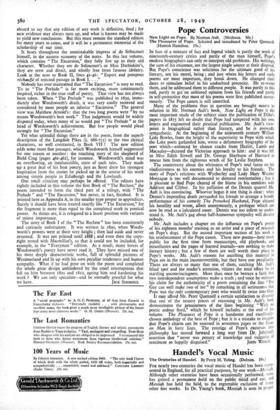Wordsworth and His Editors
THIS is the final volume of a most important work of scholarship, which has been in progress for more than twenty-five years. It wzs in 1926 that Ernest de Selincourt published his edition of Ths Prelude, in which he printed, for the first time, the original text of the poem as it was read by Wordsworth to Coleridge in Leicester- shire at the beginning of 1807. De Sclincourt followed this up with his beautiful Life of Dorothy Wordsworth. He then turned back to editing: first the Wordsworth letters, then Dorothy's Journals, finally the poems. That should have been the crown of his work, but he issued only two volumes of this edition before his death in 1943. Iz,aas been admirably carried on by Miss Darbishire. Now at last it stands complete. Matthew Arnold remarked that "almost every one who has praised Wordsworth's poetry has praised it well." The same rinzht be said of Wordsworth's editors. At least four good editions h IV appeared since his-death. This is the fifth. It is firmly basei, "1 the magnificent set of manuscripts at Dove Cottage. Earlier ed: had access to only a few of them. This is the first edition in the whole evidence they supply has been analysed and brought to bear on a study of the text. Here is its great importance. It i'
absurd to say that any edition of any work is definitive, final ; for new evidence may always turn up, and what is known may be made to yield new conclusions. But this must remain the standard edition for many years to come, and it will be a permanent memorial of the scholarship of our time.
It bears throughout the unmistakable impress of de Selincourt himself, in the austere economy of the notes. In this last volume, which contains "The Excursion," they fully live up to their old character. Whether they are de Selincourt's or Miss Darbishire's, they are terse and direct, and wholly free from fatuous idolatry. Look at the note to Book II, lines 41-46: " Expert and pompous rechauffe of rejected passage in Book L . . ."
Nobody has ever maintained that "The Excursion " is easy to read. To us " The Prelude " is far more exciting, more continuously inspired, richer in the true stuff of poetry. That view has not always been taken. When "The Prelude" was published in 185o, imme- diately after Wordsworth's death, it was very coolly received and considered by most people an inferior " Excursion." The general view was Matthew Arnold's: that the two long poems were " by no means Wordsworth's best work." That judgement would be widely disputed today, when many of us would put "The Prelude" at the head of Wordsworth's achievement. But few people would plead strongly for "The Excursion."
Yet what splendid things there arc in the poem, from the superb description of the Langdale Pikes (ii. 688-725) to the two clerical characters, so well contrasted, in Book VII ! The new edition adds some more fine passages, which Wordsworth himself suppressed for one reason or another: the touching story of the shepherd of Bield Crag (pages 461-462), for instance. Wordsworth's mind was an overflowing, an inexhaustible, store of such tales. They made up a great deal of his best poetry, just as Scott drew his strongest inspiration from the stories he picked up in the course of his work among simple people in Edinburgh and the Lowlands.
One small criticism may perhaps be offered. The editors have rightly included in this volume the first Book of " The Recluse," the poem intended to form the third part of a trilogy, with "The Prelude " and " The Excursion," but never, in fact, finished. It is printed here as Appendix A, in the smaller type proper to appendices. Surely it should have been treated exactly like "The Excursion," for the fragment is more than equal to the completed work in poetical power. As things are, it is relegated to a lesser position with variants of minor importance.
The story of Book I of the " The Recluse " has been consistently and curiously unfortunate. It was written in 1800, when Words- worth's powers were at their very height ; then laid aside and never resumed. It was not printed until 1888 ; and even then the copy- right rested with Macmillan's, so that it could not be included, for example, in the "Everyman" edition. As a result, many lovers of Wordsworth's poetry have never read it. They have missed one of his most deeply characteristic works, full of splendid pictures of Westmorland and lit up with his own peculiar tenderness and human sympathy. What if he had gone on with the poem and completed the whole great design unhindered by the cruel interruptions that fell on him between ao5 and 1812, ageing him and hardening his work ? We can only speculate—and be eternally grateful for what







































 Previous page
Previous page